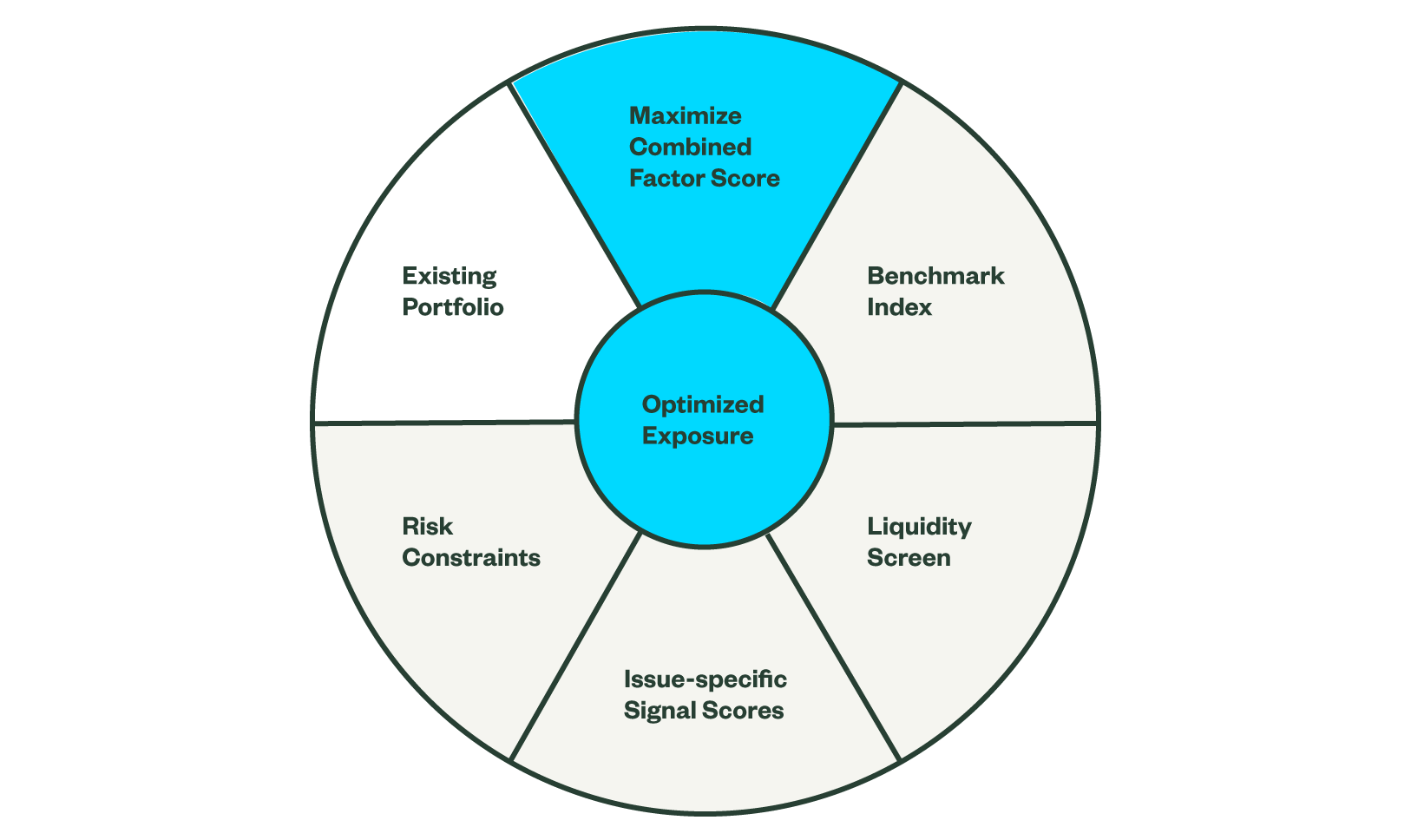Building a Portfolio: A Closer Look at Our Process
One of the most important elements of our systematic strategies is our collaboration with Barclays Quantitative Portfolio Strategy (QPS), a group that has long been recognized as one of the leaders in quantitative portfolio research. Each day, Barclays QPS provides us with a custom systematic strategy index that reflects individual signal scores for three style factors for each bond in a specified index. We use a combined score of the three signals to rank index constituents. Our process seeks to maximize exposure to high scoring bonds.
In this post, we discuss our goals for the construction of portfolios and the choices behind the signals used.
Our Goals
We designed our portfolio construction process to aim for the following goals:
- Generate alpha using systematic, data-driven signals provided by Barclays QPS. We believe that quantitative signals can be predictive of bond performance and that they can include information that traditional, fundamental analysis may miss. These signals pull information from both credit and equity markets on a daily basis and cover the entire index universe in each target market.
- Eliminate additional beta risks. We aim to limit systematic risk exposures relative to the benchmark, such as duration, quality and sector, and aim to exploit signal information through individual bond and issuer selection.
- Incorporate liquidity screening. With an eye toward implementation success, we screen out bonds with relatively poor liquidity.
As a bottom line, we want to be consistent with the “client-first” mindset that drives our team’s decision making. We need to make sure that the systematic portfolios are generating alpha, are in line with client objectives and are measured against an appropriate benchmark.
Putting the Right Signals to Work
The first systematic strategies coming out of our collaboration with QPS are focused on investment grade corporate credit where strategies are based on signals related to three factors: Value, Momentum and Sentiment.
- Value is a critical factor in credit selection, as it seeks to identify bonds that are cheap relative to their peers. Bonds are evaluated relative to peer groups based on industry, rating quality, and maturity. The model then uses corporate fundamentals to explain the excess spread of a bond relative to its peer group. The unexplained spread difference relative to peers is a signal of relative valuation.
Historically, portfolios comprising bonds with high value scores have consistently had higher average excess returns and information ratios than those portfolios with low value-scoring bonds.
- Momentum. Second, we include a momentum signal, which is based on the realized stock price performance of individual issuers. Bond issuers are ranked according to the price performance of their stock in recent months. Research shows that trends in stock prices can provide a signal of future performance in corporate bond markets. Issuers with comparatively high equity market returns persistently outperform those with low equity returns. The signal aims to distinguish between trending and volatile equity performance.
- Sentiment. Third, we include a sentiment signal, which is based on the shorting activity in the stocks of corporate bond issuers. This sentiment signal has some asymmetry: It helps predict underperformance for the relatively small proportion of issuers where shorting activity is high, but is not predictive for the large majority of issuers for which shorting activity is considered normal. Barclays QPS has documented that this sentiment signal from the equity market is a useful predictor of underperformance in corporate bond markets.
For details on our backtesting data, please contact the team.
Risk Considerations
To implement our systematic portfolios, we use the combined signal score of each individual bond in the universe in a portfolio optimization process. An important part of this process is that we incorporate risk controls to ensure that the portfolio risk profile remains aligned with the target benchmark index. Daily, we review the duration-times-spread (DTS), the duration, the sector weightings, the ratings, and the issuer concentration of our systematic portfolio versus the target benchmark index, and make sure that the portfolio remains within specified ranges of the benchmark on those parameters.
Furthermore, we want to focus portfolio rebalancing on those bonds that are more liquid and more likely to be easily traded. To identify these bonds, we consider the Trade Efficiency Score (TES), which combines recently realized turnover with estimated transaction costs. Then, we control portfolio turnover, as excessive turnover can come with elevated transaction costs and can be detrimental to net performance.
We are cognizant of transaction costs and the negative impacts they can have on portfolio outcomes. Our analysis aims at striking the right balance between actively seeking opportunities in high score securities while avoiding excessive transaction costs.
Implementation
By incorporating risk and liquidity constraints, we aim to construct portfolios that maximize the combined signal scores while controlling turnover and keeping risk parameters close to the target benchmark index (Figure 1).
Figure 1: Implementation Considerations Drive Optimization
Optimized Portfolio Structure Maximizes Risk-constrained Exposure to Style Factors

State Street Global Advisors Capabilities
Through our collaboration with Barclays QPS, we can use robust algorithmic signals to identify securities that are most beneficial for constructing systematic portfolios. However, transparency and pricing need to be considered as well. Fixed income markets are broad and fragmented, and even though the asset class has made great strides in trading efficiencies, illiquidity remains a concern for certain issuers and issues.
Our capabilities as an index manager allow us to efficiently build portfolios that maximize portfolio signal scores, limit risk exposure relative to the benchmark, and control turnover and transaction costs. We combine the Barclays QPS data excellence with our practical portfolio sampling and implementation experience.